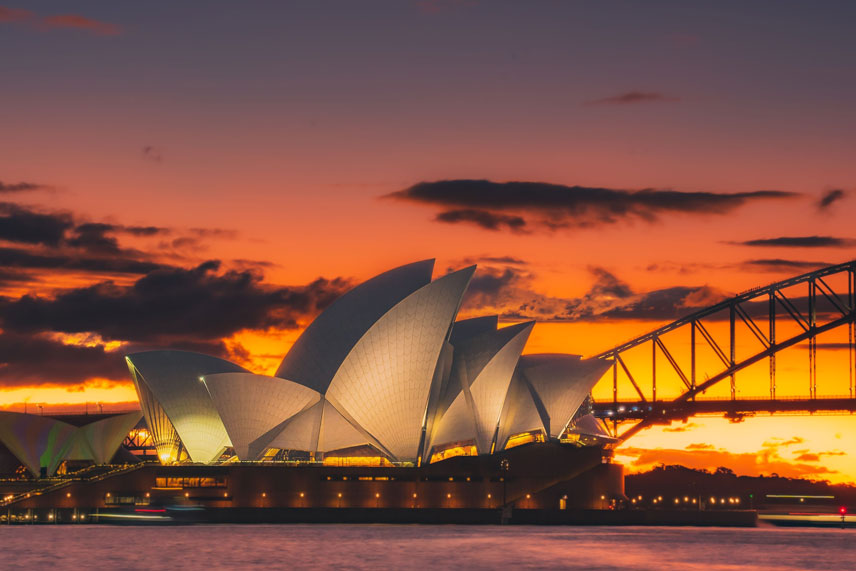The Iconic Sydney Opera House: A Masterpiece of Architecture and Culture
Perched majestically on Bennelong Point, the Sydney Opera House is one of the most recognizable structures in the world. A marvel of 20th-century architecture, it is not only a symbol of Australia’s rich cultural life but also a testament to human ingenuity, creativity, and resilience. Whether viewed from the bustling Circular Quay or across the sparkling waters of Sydney Harbour, the Sydney Opera House captivates with its bold, sail-like structures and innovative design.
Architectural Design: A Visionary Creation
The journey of the Sydney Opera House began in 1956 when the New South Wales government launched an international competition to design a national opera house for Sydney. The goal was to create a structure that would not only be functional but also iconic, representing Australia’s cultural aspirations on the global stage.
Of the 233 submissions from architects around the world, the winning design came from Danish architect Jørn Utzon, whose innovative concept of shell-shaped structures and organic forms redefined modern architecture. Utzon’s design, inspired by nature, sought to mimic the shapes of sailboats on the Sydney Harbour and the natural beauty of Australia’s coastlines.
Despite the simplicity of the concept, the design posed a formidable engineering challenge. The building’s iconic “shells” were unlike anything attempted before and required groundbreaking techniques. It took years of research, development, and innovation to realize Utzon’s vision, including the use of prefabricated, ribbed concrete panels to create the curving shells.
The Constructionof the Sydney Opera House: A Tale of Challenges and Triumph
Construction of the Sydney Opera House began in 1959, and from the outset, it faced numerous challenges. Initially estimated to take four years, the project stretched to 14 years, with costs ballooning from an initial estimate of $7 million to $102 million upon completion.
A major issue during construction was the realization that the design was ahead of its time—no existing technology could support Utzon’s vision when construction began. The engineering firm Ove Arup & Partners played a crucial role in solving many of these challenges, particularly with the roof structure. It wasn’t until 1961, two years into the project, that engineers found a way to construct the now-famous shells using pre-cast concrete segments.
Tensions between Utzon and the government over the project’s cost and delays culminated in Utzon’s resignation in 1966. The completion of the Opera House was left to other architects, including Peter Hall, who made significant changes to the interior design, which deviated from Utzon’s original plans. Though Utzon never returned to see the finished product, his vision remains intact in the building’s exterior.
The Sydney Opera House was finally completed and officially opened on October 20, 1973, by Queen Elizabeth II. Despite the delays, cost overruns, and Utzon’s departure, the reception to the building was overwhelmingly positive. It was immediately hailed as an architectural masterpiece, becoming a symbol not just for Sydney, but for Australia as a whole.
Reception and Legacy: A Global Icon
From the moment it opened its doors, the Sydney Opera House has been a hub of cultural activity. It hosts more than 1,500 performances annually, including opera, ballet, concerts, theater, and contemporary music. Some of the world’s greatest performers and artists have graced its stages, contributing to its reputation as a global cultural landmark.
The building’s unique combination of cutting-edge design and cultural significance earned it a spot on the UNESCO World Heritage List in 2007, cementing its status as one of the most significant architectural works of the 20th century. The Opera House also underwent a significant refurbishment in recent years to modernize its facilities while preserving its iconic look and feel.
Symbolism and Cultural Importance
Today, the Sydney Opera House stands as more than just an architectural feat. It symbolizes the creativity, resilience, and boldness of human spirit. For Australia, it serves as an emblem of the nation’s cultural identity, reflecting its connection to both Western and Indigenous cultures. Bennelong Point, the land on which it stands, has historical significance as the site where Woollarawarre Bennelong, a notable Indigenous figure, once lived.
Beyond its symbolism, the Opera House plays a vital role in Sydney’s tourism industry, attracting millions of visitors each year. Its forecourt hosts numerous public events, festivals, and celebrations, from the iconic New Year’s Eve fireworks to Vivid Sydney, an annual festival of light and music.
A Timeless Wonder
The Sydney Opera House remains a masterpiece of modern architecture, a global icon that continues to inspire awe. Its dramatic silhouette, innovative design, and rich cultural legacy make it one of the most important cultural institutions in the world. Whether you admire it from a distance or explore its spaces up close, the Sydney Opera House is more than just a building—it is a living testament to creativity, perseverance, and the transformative power of art and design.
If you visit Sydney, a trip to the Opera House is an unforgettable experience, offering not only a glimpse into the past of architectural marvels but also into the vibrant cultural future of Australia.


































